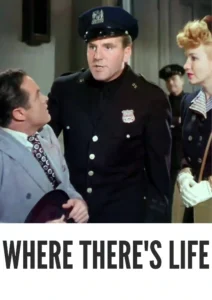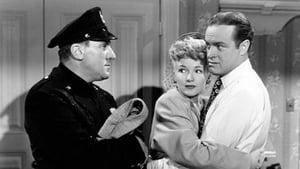Contact: info@alwanfilm.com
Video Sources 0 Views

Synopsis
Review: Where There’s Life 1947 Colorized – A Classic Comedy in the Golden Age of Hollywood

Introduction
In the pantheon of classic Hollywood comedies, “Where There’s Life 1947” holds a special place. Directed by Sidney Lanfield and featuring the inimitable Bob Hope, this film captures the essence of post-war America’s need for humor and escapism. Released in the golden age of Hollywood, “Where There’s Life” remains a testament to the era’s cinematic charm. In this article, we will delve into the delightful world of this 1947 comedy, exploring its story, cast, critical reception, and lasting legacy.
Check The Full Colorized Movies List
Check Our Colorized Movies Trailer Channel
Understanding Where There’s Life 1947 Colorized: Director, Cast, and Genre
“Where There’s Life 1947” is a prime example of the screwball comedy genre, a staple of 1940s Hollywood. Directed by Sidney Lanfield, known for his work on comedic hits, the film stars Bob Hope as Michael Valentine, a radio announcer who becomes unwittingly entangled in international intrigue. Lanfield’s direction ensures a perfect blend of humor and suspense, making the film a captivating watch from start to finish.
The cast includes Bob Hope, whose comedic timing and persona are perfectly suited to the role of the hapless yet resourceful protagonist. Alongside Hope is the talented Signe Hasso, playing the role of General Katrina Grimovitch, adding a layer of sophistication and wit to the film. The supporting cast, including William Bendix and George Coulouris, further enhances the comedic dynamics and narrative richness.
Exploring the World of Where There’s Life 1947 Colorized: Plot and Characters
“Where There’s Life 1947” follows Michael Valentine, a radio broadcaster who unknowingly becomes the heir to the throne of a fictional European country, Barovia. The current ruler, King Hubertus II, is assassinated, and Michael, as the next in line, is thrust into a web of political intrigue and danger. General Katrina Grimovitch, played by Signe Hasso, is dispatched to bring Michael to Barovia, leading to a series of comedic misadventures.
The plot weaves through various scenarios, from mistaken identities to narrow escapes, creating a tapestry of humor and suspense. Michael’s transition from a carefree radio host to a reluctant royal heir is peppered with witty dialogue, slapstick humor, and clever plot twists. The film’s characters, from the bumbling Michael to the stern yet charming General Grimovitch, are brought to life with vibrant performances and sharp comedic timing.
The Art of Film Comedy in the 1940s
The 1940s were a golden era for film comedy, characterized by sharp wit, physical humor, and clever storytelling. “Where There’s Life 1947” embodies these elements, combining fast-paced dialogue with situational comedy to create a delightful viewing experience. The era’s comedies often provided much-needed escapism for audiences grappling with the aftermath of World War II, offering laughter and light-hearted entertainment.
Early Comedy Films: A Brief History
The evolution of comedy films traces back to the silent era, where visual gags and slapstick humor dominated. As sound technology advanced, dialogue-driven humor became prevalent, giving rise to the screwball comedy genre. Films of the 1940s, such as “Where There’s Life,” built on this foundation, incorporating sophisticated wordplay, romantic entanglements, and social satire.
Where There’s Life 1947 Colorized and Its Significance
“Where There’s Life 1947” stands out not only for its humor but also for its clever integration of contemporary themes. The film reflects post-war anxieties and the American fascination with European politics, all while maintaining a light-hearted tone. Its significance lies in its ability to balance comedy with a commentary on identity, duty, and resilience.
The Debate Over Classic Comedy vs. Modern Humor
The comedy landscape has evolved significantly since the 1940s, with modern humor often favoring edgier, more explicit content. This evolution sparks debates among film enthusiasts about the merits of classic comedy versus contemporary humor. While modern comedies push boundaries and explore new territories, classic films like “Where There’s Life 1947” offer timeless wit and charm, showcasing the enduring appeal of clever writing and performance.
Examining Where There’s Life 1947 Colorized as a Classic Comedy
“Where There’s Life 1947” exemplifies the quintessential elements of a classic comedy: a charismatic lead, a series of comedic misunderstandings, and a satisfying resolution. Bob Hope’s performance is a masterclass in comedic acting, blending physical humor with sharp dialogue. The film’s pacing, direction, and narrative structure ensure a seamless blend of humor and intrigue, making it a standout in the genre.
Influence and Legacy: Where There’s Life 1947 Colorized’s Impact on Cinema
The influence of “Where There’s Life 1947” extends beyond its immediate success, contributing to the broader landscape of Hollywood comedy. Bob Hope’s brand of humor, characterized by quick wit and self-deprecation, set a standard for future comedians. The film’s success also reinforced the viability of the screwball comedy genre, paving the way for subsequent comedic endeavors in the industry.
Director’s Cinematic Legacy: Beyond Where There’s Life 1947 Colorized
Sidney Lanfield’s directorial prowess is evident in his ability to navigate different genres while maintaining a distinctive comedic style. Beyond “Where There’s Life 1947,” Lanfield directed several notable films, including “The Hound of the Baskervilles” (1939) and “My Favorite Blonde” (1942). His contributions to cinema reflect a versatility and commitment to storytelling that have left a lasting impact on the industry.
Themes Explored in Where There’s Life 1947 Colorized
At its heart, “Where There’s Life 1947” explores themes of identity, responsibility, and the intersection of ordinary life with extraordinary circumstances. Michael Valentine’s journey from a mundane existence to a life of royal intrigue mirrors broader questions about destiny and self-discovery. The film’s humor serves as a vehicle to examine these themes, making it both entertaining and thought-provoking.
Reception and Controversy Surrounding Where There’s Life 1947 Colorized
Upon its release, “Where There’s Life 1947” received favorable reviews for its humor, performances, and engaging plot. Critics praised Bob Hope’s comedic talent and the film’s ability to balance humor with suspense. While not without its detractors, who may have found the plot contrived, the overall reception highlighted the film’s appeal as a light-hearted and well-crafted comedy.
Where to Watch Where There’s Life 1947 Colorized Online
For those eager to experience the charm and wit of “Where There’s Life 1947,” the film is available on various streaming platforms and classic film archives. Services such as Amazon Prime Video, Turner Classic Movies, and Criterion Channel often feature classic films, ensuring that audiences can enjoy this timeless comedy from the comfort of their homes.
FAQs About Where There’s Life 1947 Colorized
Common queries surrounding “Where There’s Life 1947” range from its historical context to its significance in Bob Hope’s career. Addressing these frequently asked questions can provide viewers with a deeper understanding of the film’s cultural impact and its place in cinematic history.
Q: What makes “Where There’s Life 1947” a classic comedy?
A: The film’s clever blend of humor, intrigue, and stellar performances by Bob Hope and Signe Hasso contribute to its status as a classic comedy. Its witty dialogue, situational comedy, and timeless themes resonate with audiences across generations.
Q: How does “Where There’s Life 1947” reflect the post-war era?
A: The film captures the post-war era’s mix of optimism and uncertainty, using humor to address themes of identity, responsibility, and international intrigue. Its light-hearted approach provided escapism and entertainment for audiences recovering from the war’s impact.
Q: What are some other notable films by Sidney Lanfield?
A: Sidney Lanfield directed a variety of successful films, including “The Hound of the Baskervilles” (1939), “My Favorite Blonde” (1942), and “The Lemon Drop Kid” (1951). His versatility as a director is evident in his ability to navigate different genres while maintaining a distinctive style.
Conclusion
In conclusion, “Where There’s Life 1947” stands as a testament to the enduring appeal of classic Hollywood comedy. Its blend of humor, intrigue, and stellar performances continues to captivate audiences, reflecting the timeless charm of the golden age of cinema. Whether viewed in its original release or rediscovered by new generations, the film remains a shining example of the power of laughter and storytelling. As we navigate the ever-evolving landscape of comedy, let us celebrate the legacy of “Where There’s Life 1947” and the indelible mark it has left on the world of cinema.











